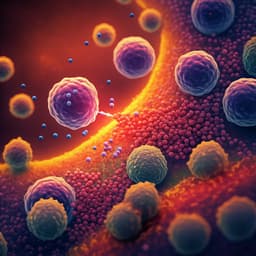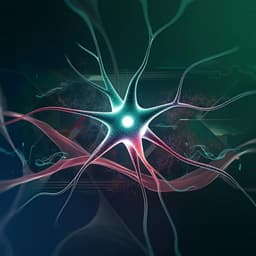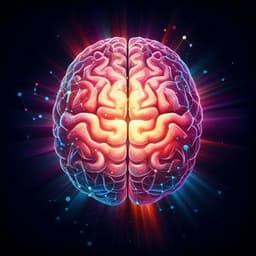
Medicine and Health
Non-invasive spinal cord electrical stimulation for arm and hand function in chronic tetraplegia: a safety and efficacy trial
C. Moritz, E. C. Field-fote, et al.
This innovative trial assessed the potential of ARCEX Therapy, combining spinal cord stimulation with rehabilitation, to enhance upper limb functionality in individuals with chronic tetraplegia. With a remarkable 72% of participants showing meaningful improvement, this research led by Chet Moritz and colleagues highlights a significant leap forward in rehabilitation techniques.
~3 min • Beginner • English
Introduction
Spinal cord injury disrupts communication between brain and spinal circuits that control movement and sensation; injuries at the cervical level often cause lasting impairment of arm and hand function. Preclinical and early human studies have shown that spinal cord stimulation, applied over segments containing relevant neuronal populations, can acutely and chronically improve motor, autonomic and sensory functions. Non-invasive transcutaneous stimulation over the cervical cord engages afferent pathways to modulate spinal networks controlling upper limbs. The ARCEX device was engineered to deliver such stimulation during rehabilitation. The Up-LIFT trial was designed to test the hypothesis that ARCEX Therapy is safe and that a majority of individuals with chronic cervical SCI would achieve clinically meaningful improvements in both strength and functional performance of the upper limbs beyond those achieved with an equivalent period of rehabilitation alone. Establishing efficacy for hand and arm recovery would address a high-priority unmet need for people living with tetraplegia and could expand neuromodulation-based rehabilitation options.
Literature Review
The authors cite extensive preclinical evidence demonstrating that targeted spinal stimulation can restore impaired functions by engaging appropriate spinal segments (e.g., locomotion, autonomic control). Human case studies and small trials report immediate improvements in standing, walking, spasticity, hemodynamics, urinary control, and upper limb functions with spinal cord stimulation (epidural and transcutaneous). Long-term stimulation during rehabilitation has been associated with neurological gains that persist after stimulation cessation, likely via reorganization and growth of residual white matter tracts onto specific neuronal populations engaged by stimulation and rehabilitation. Prior work specifically on non-invasive cervical stimulation has shown improved hand function in chronic tetraplegia and even benefits post-stroke. Standard rehabilitation alone in chronic SCI may improve function but is not expected to change neurological status substantially. These observations motivated a larger multicenter trial to systematically assess safety and effectiveness of non-invasive cervical stimulation integrated with structured rehabilitation.
Methodology
Design and oversight: Prospective, single-arm, sequential treatment, multicenter, open-label, non-significant risk pivotal trial (Up-LIFT) conducted at 14 sites (US, Canada, UK, The Netherlands) under Good Clinical Practice and the Declaration of Helsinki, with IRB/ethics approvals and an independent DSMB. Sponsor: ONWARD Medical. ClinicalTrials.gov: NCT04697472. An independent statistician conducted analyses.
Participants: Adults 22–75 years with traumatic, non-progressive cervical (C2–C8) SCI ≥12 months post-injury; AIS B, C, or D; indicated for upper extremity training; GRASSP-Prehension ≥10 or GRASSP-Strength ≥30; stable doses of anti-spasticity/pain meds (e.g., baclofen <30 mg/day if applicable). Key exclusions included uncontrolled cardiopulmonary disease, unstable medical/psychiatric conditions, severe uncontrolled autonomic dysreflexia, ventilator dependence, autoimmune etiologies, and other neurological diseases (e.g., stroke, MS, TBI). Written informed consent required.
Intervention and procedures: Participants underwent two sequential 2-month periods: (1) structured, standardized in-clinic rehabilitation alone; (2) the same rehabilitation augmented by ARCEX Therapy applied throughout each session to facilitate movement. Minimum 12 and maximum 20 in-clinic sessions per month; assessments at enrollment and monthly; all assessments performed off-stimulation. Modified intention-to-treat (mITT) required ≥24 sessions in each period (minimum 12/month).
ARCEX Therapy/device: Research LIFT device delivering transcutaneous cervical spinal cord stimulation via two surface cathodes placed approximately one vertebral segment rostral and caudal to the injury, with two large return electrodes over iliac crests or clavicles. Stimulation typically 30 Hz with a 10-kHz carrier (bursts of 10 pulses at 10 kHz, 100-µs pulse width), amplitude individualized based on motor thresholds, absence of induced movements, and comfort. Both monophasic and biphasic modes were used across sessions; amplitudes varied widely across participants.
Endpoints: Primary effectiveness endpoint: proportion of participants meeting minimally important difference (MID) for at least one strength-domain outcome AND at least one functional-domain outcome from end of rehabilitation-alone to end of ARCEX Therapy. Strength outcomes and MIDs: ISNCSCI-UEMS (+2), GRASSP-Strength (+4), pinch force (≥+2.4 N), grasp force (≥+6 N). Functional outcomes and MIDs: GRASSP-Prehension Performance (+2), CUE-T (+4). Primary safety endpoint: incidence of device-related serious adverse events (SAEs).
Secondary effectiveness: Superiority of responder rates after ARCEX versus after rehabilitation alone (McNemar’s test), and hierarchical analysis of changes from enrollment to end of rehabilitation alone versus enrollment to end of ARCEX for: pinch force, GRASSP-Prehension Performance, GRASSP-Strength, ISNCSCI-UEMS, ISNCSCI total sensory score (TSS), EQ-5D-5L, SCIM III, WHOQOL-BREF. Exploratory endpoints included pain (NRS, ISCIPDS), sleep (MOS Sleep Scale), spasticity (Penn Spasm Frequency Scale), GRASSP-Sensibility, PGIC/CGIC, PHQ-9, and others.
Statistics: One-sided exact binomial test for primary endpoint (hypothesis: >50% overall responders). McNemar’s test for responder conversion superiority. One-sided paired t-tests or Wilcoxon signed-rank tests for changes in outcomes; hierarchical testing with stopping at first non-significant endpoint (hierarchy failed at SCIM III total). Additional exploratory repeated-measures analyses (e.g., box and block test). Post hoc logistic regression to identify baseline cutoffs predicting responder status. Analyses performed in SAS 9.4.
Sample and timeline: From Jan 14–Dec 24, 2021, 65 enrolled; 60 completed protocol/assessments by June 2022 and formed the mITT for effectiveness; 64 exposed to any procedures formed the safety population. Each of the 60 mITT participants completed at least 24 sessions in each period (mean 25 per period). Database lock July 2022. Baseline demographics reflected typical cervical SCI populations.
Key Findings
Primary effectiveness: 43/60 participants (71.7%; 72%) were overall responders (met MID in ≥1 strength and ≥1 functional outcome); P<0.001 vs 50% performance goal. Strength responders: 52/60 (86.7%). Function responders: 45/60 (75.0%). Overall, 54/60 (90%) met MID for at least one strength or functional outcome.
Rehabilitation-alone vs ARCEX: 63% met MID responder criteria for functional improvements after 2 months of rehabilitation alone; responder rate after ARCEX was superior (P=0.012, McNemar). Improvements during rehabilitation alone plateaued after ~3 weeks and did not yield significant gains in neurological scores (e.g., UEMS, sensory), whereas ARCEX produced significant gains across motor and sensory domains.
Secondary/hierarchical outcomes (ARCEX minus rehab-alone period; mITT, mean ± SD; P values one-sided):
- Pinch force: +4.8±16.1 N; P=0.002 (90% CI 1.25–8.44 N)
- GRASSP-Prehension Performance: +1.6±2.9; P<0.001 (90% CI 0.9–2.2)
- GRASSP-Strength: +2.8±5.4; P<0.001 (90% CI 1.6–3.9)
- ISNCSCI-UEMS: +2.2±3.2; P<0.001 (90% CI 1.5–2.8)
- ISNCSCI Total Sensory Score (TSS): +9.6±15.1; P<0.001 (90% CI 6.3–12.8)
- EQ-5D-5L: +1.7±14.1; P=0.028
- SCIM III total: +0.5±4.2; P=0.101 (hierarchy failed here); WHOQOL-BREF domains not tested per hierarchy, though 87% reported improvement in ≥1 WHOQOL-BREF subscore or EQ-5D-5L.
Exploratory outcomes: Reduced spasm frequency (PSFS Frequency −0.2; P=0.009); improved sleep (MOS Sleep Scale: e.g., Shortness of Breath/Headache −4.3 month4–month2; P=0.03; Sleep Problems Index I −2.3; P=0.04); reduced pain (NRS −0.2; P=0.04). Box and block test improved more during ARCEX than rehabilitation alone (P<0.001). Post hoc logistic regression identified baseline cutoffs associated with higher odds of responding: UEMS ≥25, pinch ≥25 N, grasp ≥100 N, CUE-T ≥40, ISNCSCI sensory ≥120, upper extremity sensory ≥40, GRASSP-Sensibility ≥15.
Safety: No device- or procedure-related SAEs among 64 in safety population. Total 238 AEs in 50/64 participants; three SAEs (constipation, UTIs, bladder stone) unrelated to device/procedures. Seventeen participants (26.6%) had non-serious device-related AEs (44 events total). One severe spasm event occurred during rehab but off-stimulation; no unexpected AEs; no AE led to discontinuation.
Discussion
The trial demonstrates that adding non-invasive cervical spinal cord stimulation (ARCEX Therapy) to structured rehabilitation is safe and provides clinically meaningful benefits in upper limb strength, function, and sensation for a majority of people with chronic cervical SCI, surpassing gains observed with rehabilitation alone. Importantly, neurological measures (motor and sensory scores) improved only with ARCEX, addressing the hypothesis that neuromodulation can augment underlying neurological recovery rather than solely functional performance. The observed improvements in quality of life, reduced spasm frequency, better sleep, and lower pain suggest broader patient-relevant benefits. While participants showed some early functional gains during rehabilitation alone, these plateaued, whereas ARCEX sustained improvements across domains throughout the 2-month period, indicating neuromodulation-driven facilitation of spinal circuits engaged by rehabilitation. Safety was favorable with no device-related SAEs and an AE profile consistent with expectations for chronic cervical SCI populations. Post hoc analyses suggest baseline thresholds that may help identify patients most likely to respond. Mechanistically, findings align with preclinical and clinical evidence that stimulation engages afferent pathways and promotes reorganization of residual circuits when combined with task-specific practice. The sequential design cannot exclude that rehabilitation primed responsiveness to ARCEX; future work should probe interactions, optimal dosing, and durability of effects beyond two months.
Conclusion
ARCEX Therapy, a non-invasive cervical spinal cord stimulation delivered during rehabilitation, safely improves upper limb strength, function, and sensation in chronic cervical SCI, with associated gains in quality of life and reductions in spasms and pain. The multicenter Up-LIFT trial met its primary effectiveness and safety endpoints and demonstrated superiority to rehabilitation alone in responder rates and multiple objective outcomes. These results support ARCEX Therapy as a promising treatment to enhance neurological recovery of hand and arm functions in tetraplegia. Future research should optimize stimulation parameters and duration, investigate mechanisms and patient-selection criteria, evaluate earlier post-injury application, assess long-term durability of benefits, and explore applications to other neurological disorders.
Limitations
Key limitations include the open-label, single-arm sequential design without a concurrent randomized or sham control, due to the perceptible nature of stimulation and ethical/feasibility constraints; thus, placebo effects cannot be fully excluded, and rehabilitation-alone priming effects may influence ARCEX responsiveness. Cross-over designs were deemed unsuitable because ARCEX effects can persist for months, confounding subsequent periods. The fixed 2-month ARCEX duration likely underestimated maximal benefit, as no plateau was reached; longer exposure may yield additional responders and greater gains. The study enrolled only chronic SCI (≥12 months), so effects in earlier post-injury windows—where plasticity may be heightened—were not assessed. Generalizability to populations outside inclusion criteria (e.g., progressive etiologies, ventilator-dependent) is limited. Although an independent statistician was blinded, participants and therapists were not, and outcomes were assessed off-stimulation to mitigate bias. COVID-19-era constraints could have influenced AE profiles and logistics.
Related Publications
Explore these studies to deepen your understanding of the subject.







